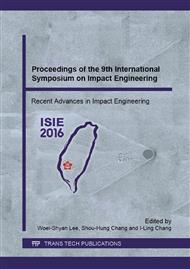p.3
p.13
p.23
p.27
p.33
p.39
p.43
p.48
p.57
Assessment of Dynamic Responses of Skin Simulant in a Drop Weight Penetration Test
Abstract:
Skin laceration injury caused by a penetration of small curvature edge frequently occurs in a domestic accident. An assessment method for this injury is necessary in order to develop a safer manufactured product. To assess the risk of skin laceration injury in a penetration accident, a skin simulant made from silicone rubber was proposed. However, mechanical responses of this skin simulant under dynamic penetration loading have not yet been investigated. In this study, a drop weight penetration test device was developed in order to simulate penetration accidents under impact velocities of over 1 m/s. The device was then used for investigating the dynamic responses of skin simulant against several blades with different tip curvature radii. Load, penetration depth, impulse and energy at rupture were then determined from the test results. Load and penetration depth at rupture increased with the increase of tip curvature radius of the blades. Furthermore, the drop weight test result showed larger response compared to the quasi-static test result which might be caused by the viscous effect and the polymer characteristics such as cross-linking of the skin simulant.
Info:
Periodical:
Pages:
33-38
Citation:
Online since:
September 2016
Authors:
Keywords:
Price:
Сopyright:
© 2016 Trans Tech Publications Ltd. All Rights Reserved
Share:
Citation:


